Introduction
![]() This guide shows how to speed up downloads in the freeware bittorrent client, Tixati. All bittorrent programs need to have their incoming and outgoing communications flow freely in order to achieve the highest download speeds and that is what this guide is about.
This guide shows how to speed up downloads in the freeware bittorrent client, Tixati. All bittorrent programs need to have their incoming and outgoing communications flow freely in order to achieve the highest download speeds and that is what this guide is about.
This guide was put together using information given by the developers of bittorrent programs at their forums, guides and FAQs. There are no secret tricks, just the real basics of proper set up of a bittorrent program. Following these simple steps should result in increased download speed.
These are the basic principles of optimizing a bittorrent client, like Tixati, for speed:
- Choose a proper port to avoid ISP blocks and conflicts with other programs
- Forward that port through any software firewall and router to allow incoming connections
- Adjust internal settings based upon upload capacity of the internet connection to allow room for outgoing communications and to distribute upload efficiently.
There are some programs that claim to optimize speed in Tixati.Such programs are a scam and generally contain adware or spyware. I have seen it said, by the developers of all bittorrent programs, that nothing will increase your download speed in a bittorrent client more than the basic steps set forth herein.
If you are not using Tixati, there are several other specific guides for other clients and a general guide here:
Optimizing Bittorrent Clients
This guide is based upon Version 1.93 of Tixait.
Accessing Settings
Press the "Settings"icon up top

Choosing A Proper Port
To avoid messing up a network connection that is already cleared, first check and see if your communications are blocked or are already clear. Have Tixati running while testing the port.
Click to Test Your Port Success-just go to Adjusting Internal Settings.Error- follow all steps.
The TCP and UDP port numbers selected are at Settings>Network>Incoming Ports


If you failed the port test above, then you should first set your port to a proper one. The most important choice here is to avoid using a port within the 6881-6999 range. This was the range originally used by bittorrent programs and is often blocked by Internet Service Providers (ISPs). (If your port was in this range, change and re-test).
The safest choice is a port in the 49160-65534 range as this will avoid ISP blocks and possible conflicts with other applications. This range used to be 49152-65534, but apparently Vista and Windows 7 grabs some of those ports in between. Vuze-Wiki: Port is Blacklisted
Windows users, if you want to make certain there is no conflict. Go to the command prompt and type in netstat -a >c:\log.txt This will check to see which ports are being used and save a log text file at C:\. Looking at the text file, you will know which ports to avoid.
To change the port, press the change button and another screen will pop up where the port number may be changed.
Again, the setting for the TCP and UDP port numbers is at Settings>Network>Incoming Ports


After pressing "Change", you will see this screen. TCP and UDP should be set to same port number.
TCP/UDP Port For Peer Connections UDP Port For DHT Messages
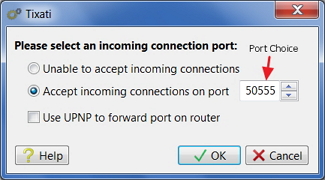
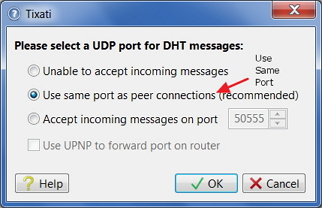
Introduction
A router will block incoming communications unless an exception is made. All software firewalls will block incoming communications and most will also block outgoing communications, unless an exception is made. If you are "firewalled", then other people will not be able to initiate connections with you (see Why Is Being Firewalled Bad).
As there are many firewalls and routers, this guide can not give explanations as to each. However, there are guides available, on the internet for most firewalls and routers and this guide will link you to them. Note that PortForward.com does not have guides specific to Tixati. Choose a µTorrent guide and substitute Tixati where µTorrent is indicated.
Software Firewall - The permission should be set to allow TCP and UDP in both directions. Generally, you will have a choice to set permission for the Tixati port or for the Tixati program. Setting permission for the port is the safer choice. You can check these options for guides:
- The help file of your software firewall is the best place to look
- The µTorrent forum has some guides posted
- PortForward.com Firewall Guides(choose firewall and then µTorrent) also has some guides.
Router - There are two choices here. The easier way is to use UPnP. However, this has a possible security issue. Using UPnP allows any program to create a port mapping through the router without consent of the owner. Note: Given the recent findings of Rapid7 regarding security flaws in UPnP, it is generally suggested here that manual forwarding be used. If you still want to use UPnP, then it would be a good idea to test and see if your device is vulnerable to attack through UPnP.
The other choice is to manually forward the port through the router. This does not have that security issue, but involves going through several steps to accomplish. Using the guides linked herein, this should not be that difficult and is the preferred method.
UPnP - The Easy Way - Enable UPnP in Tixati and router.
In Tixati the setting for UPnP is at Settings>Network>Incoming Ports. Press the change button near the TCP and UDP port numbers and the screen below will pop up. UPnP is enabled at default, if not on yours enable by entering check in box. UPnP must be set for both TCP/UDP Port For Peer Connections and UDP Port For DHT Messages. If you have set the UDP Port For DHT Messages to Use Same Port as TCP/UDP Port For Peer Connections, then you only need to enable UPnP in TCP/UDP Port For Peer Connections as in image below:
TCP/UDP Port For Peer Connections
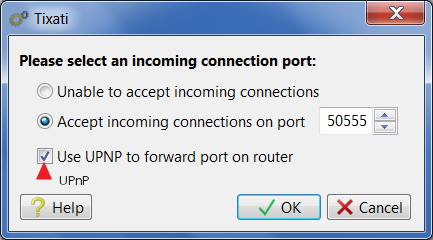
Manual Forwarding-The Preferred Way
- UPnP (NAT-PMP) Must be disabled in Tixati (see image above)
- Use the Static IP Guide
-
Set permission for Tixati port. This should be set to allow both TCP and UDP communications.
You can check these options for guides:
- The help file of your router is the best place to look
- Portforward.com µTorrent Router Index has guides for most routers
Click Here to Re-Test Port Success-Proceed to next step. Error- re-do steps or seek help in Forums. Have Tixati running while re-testing the port.
Adjusting Internal Settings
Introduction
The most important setting here is to cap upload in Tixati to 80% of your overall upload capacity. Setting upload in Tixati is a fine line. The more upload you give, the more download you will get from other peers. However, if upload is set too high, or to unlimited, then download speeds will suffer as outgoing communications (acknowledgment signals, resend requests etc) will be interfered with. Other adjustments are made here to distribute your upload so that you receive back the most download from other peers.
Speed Test: Speedtest.net (Click for Test)
First the upload capacity of your internet connection must be determined by taking an online speed test. Speedtest.net has test locations worldwide and will highlight the one closest to you.
To take the test you must have Flash installed and javascript enabled.
Before taking the speed test, press Settings in the upper right of the speedtest.net page. This will take you to another page. At the bottom of that page is the "Global Settings" options. Set "Speed Measurement" to kilobytes and press "Save" . This will facilitate entry into the calculator below and will lessen confusion as qBittorrent shows speeds in kilobytes.



You should stop all internet activity, including torrents, before taking the test and the test should be taken a few times to obtain a reliable average. Results will now show in KiloBytes. It is the upload rate that is important here.

Another Way To Test Upload Speed
For most people these test results will be reliable (Comcast users see Note). However, you may wish to do a double check on real life upload speed. When you are active on a torrent with a good number of peers and you are using your upload cap, set upload to unlimited and watch for about 5-10 minutes and see where upload settles in at. Then input that number into the calculator in the kiloBytes section.
Note: Some ISPs will show inaccurate results on the speed test. If your ISP has anything like Comcast's PowerBoost, then your results will show higher than the actual speed of your connection. PowerBoost provides a burst of download and upload speeds above your provisioned download and upload speeds for the first 10MB and 5MB respectively. Since the speed test involves relatively small files, this will skew results upward.
If you have PowerBoost, or something similar, my findings from my own results and those of others is that the actual speeds are 60% of the test result. So if you get 200kB/s for upload at the test, you should enter 120 in the kB/s box in the calculator. Using Google ("speed result" x .6) will get the proper number to enter in the calculator and this actually turns out to be very accurate. You should end up with the calculator showing a cap that is about half of the test result.
Calculator: Azureus Upload Settings Calculator
Once you have an average upload speed for your connection go to the online Azureus Upload Settings Calculator. Although designed for Azureus, this calculator will work for all bittorrent clients.
This calculator was created by the8472 a contributor to Vuze (fka Azureus) and part of the team that created Bittorrent Protocol Encryption.
Enter your average upload speed in the appropriate box

The calculator will automatically give the proper figures to adjust bandwidth, connections and queue options in Tixati.



Bandwidth - On the Bandwidth screen, at the top are the options to limit incoming and outgoing. Only outgoing should be limited.
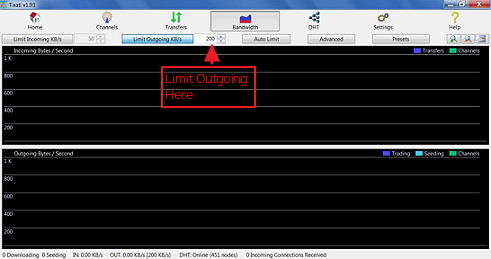
The Maximum KBs should be set to calculator number that you get after inputing upload speed from speed test.. Clicking on the Limit Outgoing KB/s button will turn the button blue, which means it is activated. Do not click on the Limit IncomingKB/s button.


Connections Tixati only has a setting for Maximum peer connections per transfer. The calculator setting for "Maximum number of connections per torrent" should be entered here. The Maximum concurrent outgoing connection attempts option should be set at 8 for Windows machines. It can be set to 100 for Linux machines, although setting it higher does not help download speed. I could find no information on the Maximum concurrent outgoing UDP connection attempts, so I suggest leaving it at the default.
The setting is located at Settings>Network>Connections


Queue Tixati does not have a "max active torrents" setting, so that result in the calculator should be entered in the "Upload Slots" setting in Tixati. The boxes to recycle upload and download slots should be unticked as this will result in too many torrents running.
The settings for Queue options are at Settings>Transfers>General
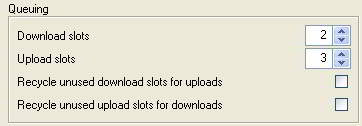
Peer Sources & Encryption
Having the proper peer sources enabled, such as Peer Exchange (PEX) and Distributed Hash Table (DHT), will help download speeds as they will help you find additional seeds and peers for a torrent.
Encryption was primarily designed to thwart Internet Service Providers interference with bittorrent. Having encryption enabled and allowing incoming legacy (non-encrypted) connections will provide you with the largest pool of seeds/peers to select from.
The setting for Peer Exchange is at Settings>Transfers>General and should be set as in image below. SSDP Local Peer Discovery is for finding peers on your LAN. Even if you are on an extended LAN, I suggest disabling this as communications are not encrypted and allow anyone on your LAN to identify and log any transfers that are being announced.

The setting for DHT is at Settings>DHT. The top setting should be set to "On" . The other settings leave unchanged.

The settings for Encryption are located at Settings>Network>Connections. Setting "Outgoing" to "encrypted preferred" and "Incoming" to "Accept either" will result in the maximum number of seeds/peers being connectable, while encrypting as many connections as possible.

IPV Settings
In going through the settings, I noticed that the default setting on my Tixati for this was set to IPV4 only. I am not sure how much affect this would have, but it seemed wrong to only accept IPV4. There are settings for IPV4 and IPV6 "preferred" as opposed to "only" and I would suggest using the "preferred". I have set mine to "IPV4 preferred" and would think for most people that would be the correct setting.
The setting for IPV is at Settings>Network>Connectons

Good Torrents
The general rule here is to choose torrents that have a high seed to peer ratio. Seeds have 100% of the content associated with the torrent and are only uploading to peers. Peers also upload to other peers, but are also looking for other peers to upload to themselves and their download capacity is almost always higher than their upload capacity.
This applies even though one swarm has significantly more active users than another. For example, a torrent with 30 seeders and 70 peers (30% seeders) will generally be faster than one with 500 seeders and 2500 peers (20% seeders) as the average upload capacity available to the peers will be higher. (TorrentFreak).
For more information see Good Torrents
Related Articles
- Searching for Torrents Popular and unique torrent search sites, with comments.
- Finding Legal (and Free) Torrents sites that offer only legally downloadable and distributable content.
Gizmo's Best Ever Freeware Forums
If you still have issues after using this guide and would like some assistance, you may post here or our Forums. The comments section here is not well set up for ongoing discussions, so the forums are a better place.
When posting on a speed issue, please provide
- Your speed test result for both upload and download speed in kiloBytes per second (kBps)
- Your result at canyouseeme, both before taking any steps and after. Just indicate Success or Error do not post your IP address.
If you have a suggestion or correction for the guide, please post here.
Those who wish to post a thanks may post here or in the forums. I always appreciate hearing from those who this helped and I do read the posts regularly. I used to respond to each thanks, but realized it was clogging up the comments section. I thank all those who have posted their appreciation and all those who will.
So, to those who post a "Thanks", I appreciate it.
 We are looking for people with skills or interest in the following areas:
We are looking for people with skills or interest in the following areas:

Comments
I did everything in the guide my port even tested success but my downloads are still so slow and my DHT says port unconfirmed what can I do to fix this
and my speed test results are
download speed: 104.6kB/s
upload speed: 40.3kB/s
port: 64697
Hello
If you could pls help me understand:
1.Why do torrent clients keep downloading even when no file is downloaded?
2.I noticed Tixati download much more bytes then what is shown against the file downloaded. How can this aspect be managed to keep extra/waste download at the minium
thanks
Can someone help. I am having some problems with UTorrent, and would like to try one of your recommended progams - looking at qtorrent for now. Is there any way to transport the finished files from utorrent to qtorrent, or any another.
Thanks. Will try it out and let you know the results. Again, THANKS.